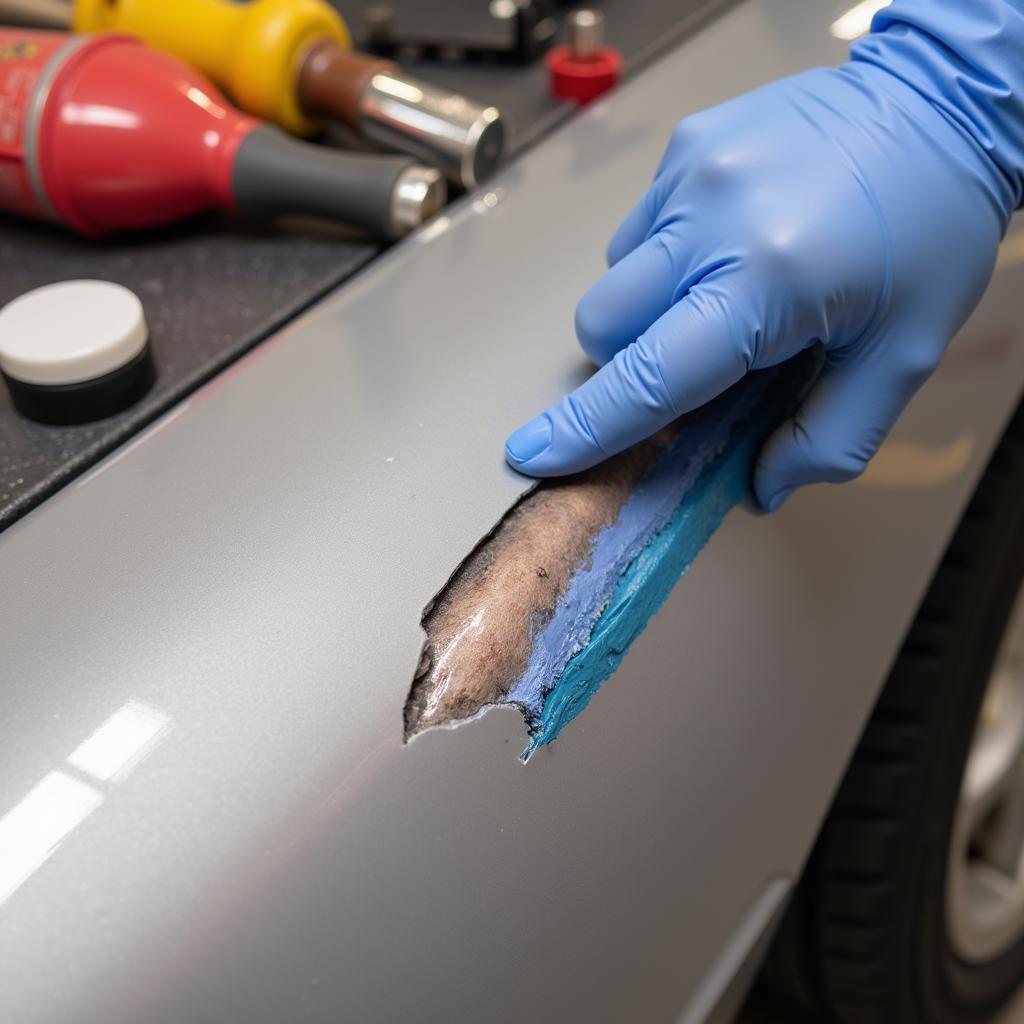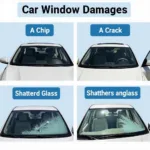A deep scrape on your car’s paint can be frustrating, but often, you can repair it yourself. Understanding the severity of the damage and choosing the right repair method is crucial for achieving a professional-looking result. This guide provides a step-by-step approach on how to repair a deep scrape on your car paint, saving you a potentially costly trip to a body shop.
Assessing the Damage: Light Scrape vs. Deep Scrape
Before you start, determine the extent of the scrape. A light scrape might only affect the clear coat, while a deep scrape penetrates the color coat or even the primer. Knowing the depth will determine the appropriate repair method. If the scrape is light and you can’t feel it with your fingernail, you might be able to get away with just polishing. For deeper scrapes, you’ll need to use touch-up paint and possibly even a filler. If you’re unsure, consulting a professional for car paint scuff repair brentwood might be a good idea.
Gathering Your Supplies for Car Paint Repair
Having the right tools and materials is essential for a successful repair. You’ll need:
- Automotive touch-up paint (matched to your car’s color code)
- Primer (if the scrape reaches the metal)
- Fine-grit sandpaper (2000-3000 grit)
- Rubbing compound
- Polishing compound
- Wax
- Clean microfiber cloths
- Masking tape
- Applicator pads or brushes
- Putty knife (if using filler)
Step-by-Step Guide to Repairing a Deep Scrape
- Clean the Area: Thoroughly wash and dry the scraped area to remove any dirt or debris. Use a degreaser if necessary.
- Mask the Surrounding Area: Use masking tape to protect the surrounding paint from accidental sanding or overspray.
- Sand the Scrape: If the scrape is deep enough to feel with your fingernail, start with a slightly coarser grit sandpaper (1500 grit) to smooth out the edges of the scrape. Then, use finer-grit sandpaper (2000-3000 grit) to feather the edges and blend the area with the surrounding paint. For advice on fixing bumper damage, see our guide on how to repair paint damage on car bumper.
- Apply Primer (if necessary): If the scrape has reached the metal or primer layer, apply a thin coat of automotive primer to the exposed area. Allow it to dry completely before proceeding.
- Apply Touch-Up Paint: Apply thin coats of touch-up paint to the scraped area, allowing each coat to dry completely before applying the next. It’s better to apply multiple thin coats than one thick coat to avoid runs and drips.
- Sand and Level the Paint: Once the touch-up paint is dry, use fine-grit sandpaper (2000-3000 grit) to carefully level the paint with the surrounding area. This process might require multiple rounds of sanding and paint application.
- Compound and Polish: Use rubbing compound to remove any remaining scratches from the sanding process. Follow up with polishing compound to restore the shine and gloss to the repaired area. You can learn about repairing road rash damage in our guide on car road rash paint repair.
- Wax: Apply a coat of wax to protect the repaired area and blend it seamlessly with the rest of the car’s paint. For information on removing tree sap from car paint, refer to our guide on tree sap car paint damage repair.
Tips for a Professional Finish
- Work in a well-ventilated area.
- Use high-quality products for best results.
- Patience is key, especially when sanding and applying paint.
- If you’re unsure about any step, consult a professional. You can find resources for car paint scratch repair malaysia online.
Conclusion
Repairing a deep scrape on your car paint might seem daunting, but with patience and the right techniques, you can achieve a professional-looking result and save money. By following these steps, you can restore your car’s appearance and protect it from further damage.
FAQs
- Can I use nail polish to repair a car scratch? No, nail polish is not formulated for automotive paint and will not provide a durable or lasting repair.
- How long does it take for touch-up paint to dry? Drying time varies depending on the product and environmental conditions, but it usually takes between 30 minutes to an hour for each coat.
- What if the scrape is too deep to repair myself? If the scrape is very deep or extensive, it’s best to consult a professional auto body shop.
- How can I prevent future scrapes? Park carefully, avoid tight spaces, and be mindful of obstacles when driving.
- Can I use a hairdryer to speed up the drying process? While a hairdryer can help, be careful not to overheat the paint, which could cause it to bubble or crack.
Need help with car repairs? Contact us via WhatsApp: +1(641)206-8880, or Email: [email protected]. We have a 24/7 customer support team.


